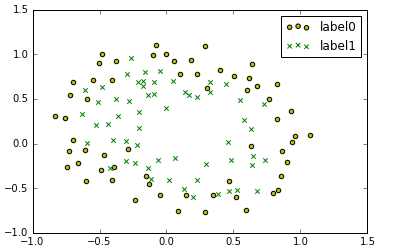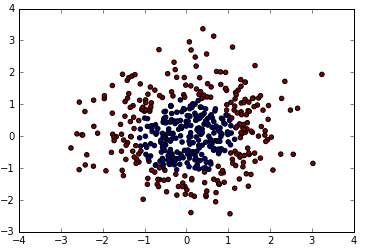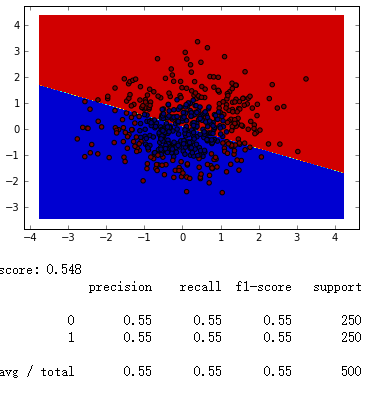目录
非线性逻辑回归和线性逻辑回归原理差不多,但是非线性逻辑回归的决策边界是一条曲线
梯度下降法实现非线性逻辑回归代码
- 导入所用的包
import numpy as np
import matplotlib.pyplot as plt
from sklearn.metrics import classification_report #对模型进行评估
from sklearn import preprocessing #对数据做标准化
from sklearn.preprocessing import PolynomialFeatures
#数据是否需要标准化
scale = False
%matplotlib inline- 导入数据对数据进行处理,画散点图
data = np.genfromtxt('LR-testSet2.txt',delimiter = ',')
x_data = data[:,:-1]
y_data = data[:,-1,np.newaxis]
def plot():
x0 = []
y0 = []
x1 = []
y1 = []
for i in range(len(x_data)):
if y_data[i] == 0:
x0.append(x_data[i,0])
y0.append(x_data[i,1])
else:
x1.append(x_data[i,0])
y1.append(x_data[i,1])
#画图
scatter0 = plt.scatter(x0,y0,c='y',marker='o')
scatter1 = plt.scatter(x1,y1,c='g',marker='x')
#画图例
plt.legend(handles = [scatter0,scatter1],labels=['label0','label1'],loc ='best')
plot()
plt.show()
- 定义多项式回归
#定义多项式回归,degree的值可以调节多项式的特征
poly_reg = PolynomialFeatures(degree = 3)
#特征处理
x_poly = poly_reg.fit_transform(x_data) #degree = 3 x_poly = x^0 x^1 x^2 x^3- 实现sigmoid函数以及代价函数
def sigmoid(x):
return 1.0/(1+np.exp(-x))
def cost(Xmat,Ymat,ws):
left = np.multiply(Ymat,np.log(sigmoid(Xmat*ws)))
right = np.multiply(1-Ymat,np.log(1-sigmoid(Xmat*ws)))
return np.sum(left+right) / -(len(Xmat))
def gradAscent(Xarr,Yarr):
if scale == True:
Xarr = preprocessing.scale(Xarr)
Xmat = np.mat(Xarr)
Ymat = np.mat(Yarr)
lr = 0.03
epochs =50000
costList = []
m,n = np.shape(Xmat) #行代表数据的个数,列代表权值的个数
ws = np.mat(np.ones((n,1))) #初始化权值
for i in range(epochs+1):
h = sigmoid(Xmat*ws)
ws_grad = Xmat.T*(h - Ymat)/m
ws = ws - lr *ws_grad
if i % 50 ==0:
costList.append(cost(Xmat,Ymat,ws))
return ws,costList- 调用函数
ws,costList = gradAscent(x_poly,y_data)- 画图
x_min,x_max = x_data[:,0].min() -1,x_data[:,0].max()+1
y_min,y_max = x_data[:,1].min() -1,x_data[:,1].max()+1
#生成网格矩阵
xx,yy = np.meshgrid(np.arange(x_min,x_max,0.02),np.arange(y_min,y_max,0.02))
z = sigmoid(poly_reg.fit_transform(np.c_[xx.ravel(),yy.ravel()]).dot(np.array(ws)))
for i in range(len(z)):
if z[i] > 0.5:
z[i] = 1
else:
z[i] = 0
z = z.reshape(xx.shape)
#画等高线图
cs = plt.contourf(xx,yy,z)
plot()
plt.show()

- 做预测
def predict(x_data,ws):
# if scale == True:
# x_data = preprocessing.scale(x_data)
Xmat = np.mat(x_data)
ws = np.mat(ws)
return [1 if x >= 0.5 else 0 for x in sigmoid(Xmat*ws)]
predictions = predict(x_poly,ws)
print(classification_report(y_data,predictions))预测结果:

sklearn实现非线性逻辑回归代码
- 导入所用的包
import numpy as np
import matplotlib.pyplot as plt
from sklearn import linear_model
from sklearn.metrics import classification_report
from sklearn.datasets import make_gaussian_quantiles
from sklearn.preprocessing import PolynomialFeatures
%matplotlib inline- 随机生成散点,打印出
x_data,y_data = make_gaussian_quantiles(n_samples = 500,n_features = 2,n_classes =2)
plt.scatter(x_data[:,0],x_data[:,1],c=y_data)
plt.show()
- 训练模型
logistic = linear_model.LogisticRegression()
logistic.fit(x_data,y_data)- 画图 ,做预测
x_min,x_max = x_data[:,0].min() -1,x_data[:,0].max()+1
y_min,y_max = x_data[:,1].min() -1,x_data[:,1].max()+1
#生成网格矩阵
xx,yy = np.meshgrid(np.arange(x_min,x_max,0.02),np.arange(y_min,y_max,0.02))
z = logistic.predict(np.c_[xx.ravel(),yy.ravel()])
z = z.reshape(xx.shape)
#画等高线图
cs = plt.contourf(xx,yy,z)
plt.scatter(x_data[:,0],x_data[:,1],c=y_data)
plt.show()
print('score:',logistic.score(x_data,y_data))
predictions = logistic.predict(x_poly)
print(classification_report(y_data,predictions))

我们可以看到,在没有定义多项式回归,决策边界是一条直线,准确率只有0.55
- 定义多项式回归 ,画图,做预测
#定义多项式回归,degree的值可以调节多项式的特征
poly_reg = PolynomialFeatures(degree = 5)
#特征处理
x_poly = poly_reg.fit_transform(x_data) #degree = 3 x_poly = x^0 x^1 x^2 x^3
logistic = linear_model.LogisticRegression()
logistic.fit(x_poly,y_data)
x_min,x_max = x_data[:,0].min() -1,x_data[:,0].max()+1
y_min,y_max = x_data[:,1].min() -1,x_data[:,1].max()+1
#生成网格矩阵
xx,yy = np.meshgrid(np.arange(x_min,x_max,0.02),np.arange(y_min,y_max,0.02))
z = logistic.predict(poly_reg.fit_transform(np.c_[xx.ravel(), yy.ravel()]))
z = z.reshape(xx.shape)
#画等高线图
cs = plt.contourf(xx,yy,z)
plt.scatter(x_data[:,0],x_data[:,1],c=y_data)
plt.show()
print('score:',logistic.score(x_poly,y_data))
predictions = logistic.predict(x_poly)
print(classification_report(y_data,predictions))

如上图,我们可以看到,决策边界是一条曲线,准确率达到了0.98。























 2366
2366











 被折叠的 条评论
为什么被折叠?
被折叠的 条评论
为什么被折叠?








